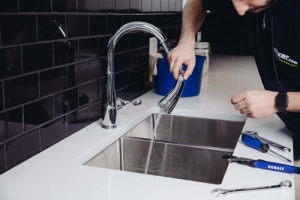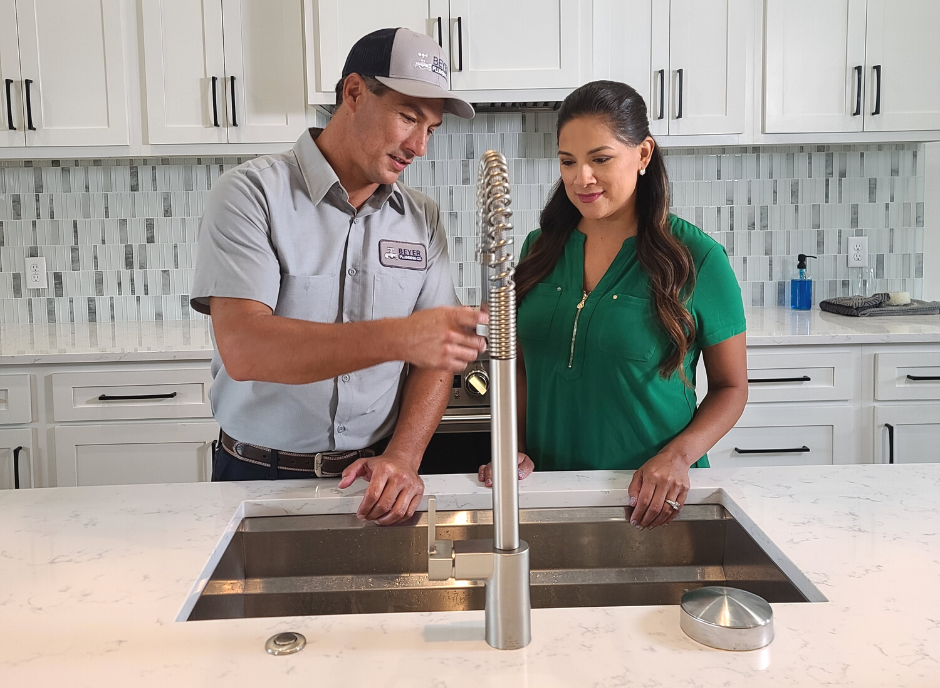Your Relevance of Addressing a Faulty Faucet
Your Relevance of Addressing a Faulty Faucet
Blog Article
What're your opinions about Leaky Faucets: Why They Happen & What to Do About Them?

Dripping taps might appear like a small inconvenience, but their effect exceeds just the nuisance of the audio. From drainage to incurring unnecessary financial expenses and health and wellness threats, overlooking a dripping faucet can result in different repercussions. In this write-up, we'll delve into why it's vital to resolve this common household issue promptly and efficiently.
Waste of Water
Environmental Effect
Leaking taps contribute substantially to water waste. According to the Environmental Protection Agency (EPA), a single faucet dripping at one drip per second can waste more than 3,000 gallons of water per year. This not just pressures water sources but likewise affects communities and wildlife dependent on them.
Financial Costs
Raised Water Costs
Past the environmental impact, trickling taps can inflate water bills considerably. The gathered wastefulness gradually translates into greater utility expenses, which could have been stayed clear of with prompt repair work.
Possible Property Damages
Additionally, prolonged trickling can cause damage to components and surface areas surrounding the tap. Water build-up can cause discoloration, deterioration, and even structural problems if left unattended, leading to additional fixing expenses.
Health Problems
Mold and Mildew Development
The constant visibility of wetness from a dripping tap creates an excellent atmosphere for mold and mildew and mildew development. These fungi not just compromise interior air quality yet also posture health threats, particularly for people with respiratory problems or allergies.
Waterborne Illness
Stationary water in dripping faucets can come to be a breeding ground for microorganisms and other microorganisms, increasing the danger of waterborne conditions. Pollutants such as Legionella microorganisms thrive in stagnant water, potentially leading to significant diseases when ingested or breathed in.
DIY vs. Specialist Repair service
Benefits and drawbacks of DIY Repair
While some might try to fix a leaking tap themselves, do it yourself repair services come with their very own set of difficulties. Without proper knowledge and devices, do it yourself attempts can intensify the problem or lead to incomplete repair work, lengthening the trouble.
Advantages of Hiring an Expert Plumber
Employing a specialist plumber makes certain that the underlying source of the dripping faucet is dealt with successfully. Plumbers possess the knowledge and devices to identify and fix tap problems successfully, conserving time and lessening the danger of more damages.
Step-by-Step Overview to Taking Care Of a Dripping Tap
Devices Called for
Prior to trying to take care of a leaking tap, gather the needed tools, including a flexible wrench, screwdrivers, substitute components (such as washing machines or cartridges), and plumber's tape.
Usual Tap Issues and Their Solutions
Determine the kind of faucet and the particular issue causing the drip. Common issues consist of worn-out washers, corroded shutoff seats, or damaged O-rings. Describe maker directions or on the internet tutorials for step-by-step guidance on repairs.
Safety nets
Routine Maintenance Tips
To prevent trickling taps, carry out routine upkeep such as cleansing aerators, checking for leaks, and changing damaged parts promptly. In addition, take into consideration installing water-saving devices or updating to much more efficient components.
Value of Prompt Repair Works
Dealing with trickling taps as soon as they're noticed protects against additional water wastefulness and prospective damage, inevitably conserving both water and money in the future.
Effect On Home Value
Assumption of Well-Maintained Home
Maintaining a property in good condition, consisting of dealing with upkeep issues like trickling faucets, enhances its regarded value and worth among possible buyers or lessees.
Influence on Resale Worth
Residences with properly maintained plumbing components, consisting of taps, command greater resale values in the real estate market. Dealing with leaking taps can contribute to a positive impact throughout building assessments and negotiations.
Ecological Responsibility
Private Payment to Conservation
Taking obligation for fixing dripping faucets lines up with broader efforts towards water conservation and environmental sustainability. Every person's activities collectively make a substantial impact on maintaining precious resources.
Lasting Living Practices
By focusing on punctual repair work and embracing water-saving behaviors, individuals contribute to lasting living techniques that benefit both present and future generations.
Final thought
Resolving a dripping faucet surpasses mere ease; it's a vital action toward saving water, lowering financial costs, and protecting wellness and property. Whether with do it yourself fixings or specialist assistance, acting to take care of dripping faucets is a little yet impactful method to advertise responsible stewardship of resources and contribute to a much healthier, a lot more lasting future.
How to Fix a Leaky Faucet: Step-by-Step Repair Guide
A leaky faucet may seem like a simple annoyance, but if it's not fixed promptly, that leak could cost hundreds to potentially thousands. From water damage to mold, mildew, and high water bills, even a tiny leak can be catastrophic if left unattended. Damage like this can even affect the overall value of your home, so it's important to take the right approach for leaky faucet repair. You may need the help of a plumber in some cases, but we've got a few tips you can try on how to fix a leaky faucet before calling the pros.
Four Faucet Types
When you're learning how to fix a leaky faucet, the first step is knowing what kind of faucet you're working with! There are four common types.
Cartridge Faucets
Cartridge faucets come in one- or two-handled varieties. In one-handled cartridge faucets, hot and cold water combines in a single cartridge. In the two-handled versions, hot and cold water are controlled separately and mixed in the faucet.
Ball Faucets
Ball faucets have a single lever you push up and down to adjust the pressure and rotate to change the temperature. A slotted metal ball controls the amount of water allowed into the spout.
Compression Washer Faucets
They're the oldest type of faucet, but they're still used in many homes — especially older ones. Compression faucets have two separate handles that, when turned, raise or lower the washer that seals a water valve. This valve stops water from flowing through the faucet when it is turned off.
Disc Faucets
Disc faucets rarely need to be repaired due to their maintenance-free design. The water flow is controlled by two discs — the upper one raises and lowers against a fixed lower disc, creating a watertight seal. If your disc faucet starts leaking, you may need to replace the seals or clean residue buildup from the inlets.
Fixing a Leaky Faucet
Step 1: Turn Off the Water
Whether you're learning how to fix a leaky bathtub faucet or how to fix a leaky kitchen faucet, always turn off the water supply to your working area when you're fixing a leak. The last thing you want is a flood added to your list of things to fix.
Look for the shutoff valves below your sink or around the tub and turn them clockwise to stop the water flow. If your faucet doesn't have shutoff valves, you may need to turn off the water for the whole house. Check to make sure it's off by turning the faucet on. If nothing comes out, you're ready to start the repair.
Step 2: Take Apart the Faucet
How you disassemble your faucet depends on the type of fixture you have. You can use a flathead screwdriver to remove the caps on top of the handle or handles for cartridge and compression faucets. Inside, you should see handle screws. Unscrew these with a screwdriver to remove the handle.
Disc- and ball-style faucets will typically have an inlet screw near the handle, and removing that will reveal the interior of the faucet.
Detach the Valve Stem
For cartridge- and compression-style faucets, you'll see the inner valve stem or cartridge once you remove the faucet handles. If you have a compression faucet, unscrew the brass valve stem. If you have a cartridge faucet, pull out the cartridge. If your cartridge has been in place for a while, it may require some tools or extra force to remove it due to mineral deposits.
Examine and Replace Parts
Once you've removed the parts, check them out to confirm what needs to be replaced. You may see corroded rubber washers, O-rings, stems, or cartridges. On a ball-style faucet, check the seats and springs for damage.
If you need to repair a leaky disc faucet, check the inlet and seals on the lower disc.
Once you determine what parts must be replaced, visit your local hardware store. Bring the damaged parts with you to ensure you can purchase the correct components to replace them.
Clean Valves and Faucet Cavity
If you've removed a stem or cartridge, you may notice mineral buildup in the faucet's threads. Use white vinegar to clean the valve seat by soaking it for a few minutes, then scrub it away with a soft toothbrush and rinse with warm water. You can also clean the interior of the faucet in the same way.
Reassemble the Faucet
Once your faucet is cleaned and the required parts have been replaced, it's time to reassemble it. Put the pieces back together and slowly turn the water supply back on. Doing this slowly is crucial because too much initial water pressure can damage the new hardware you've just installed.
https://homewarranty.firstam.com/blog/how-to-fix-leaky-faucet

I was introduced to that write-up on How to Fix a Dripping or Leaky Faucet from a friend on another web property. For those who enjoyed our article please be sure to share it. I enjoy reading our article about 4 Common Reasons for a Leaky Faucet.
Report this page